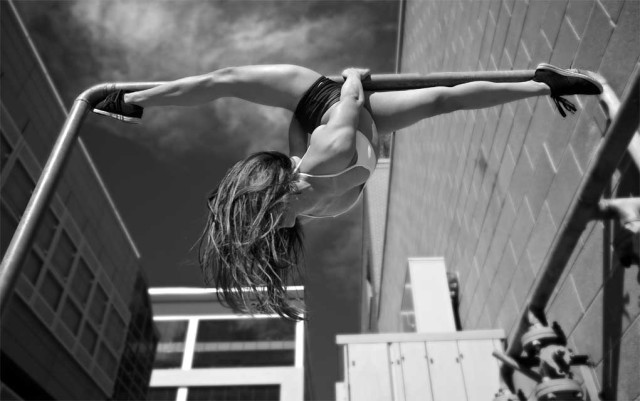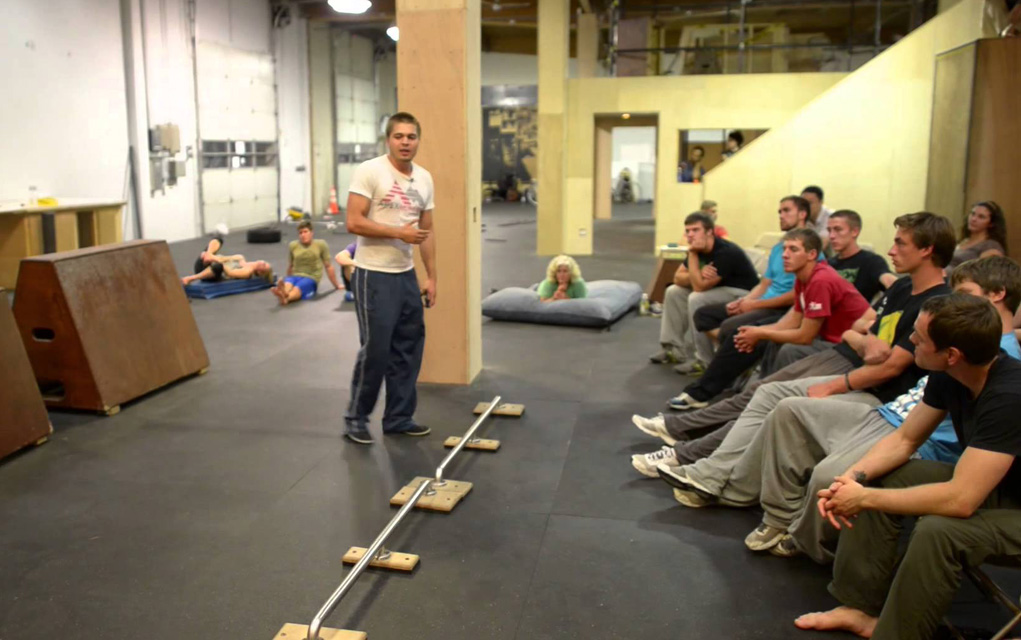
Before you stop reading this because you see the word “parkour” and think you know what it is (leaping over the airy gaps between skyscrapers), who does it (crazy people), and that it couldn’t possibly benefit you as a runner/cyclist/triathlete/yogi/etc. (it can), think about this:
As children, we gravitate toward obstacles. That big slushy puddle? Splash! The curb in front of the grocery store? One tiny foot in front of another, we practice balance. A railing? Why not just hang for a while? Through movement, kids explore their physical surroundings — and their potential — and in the process learn focus and presence and the sense of accomplishment that can only be gained by facing a challenge head-on. If at first they don’t succeed? You know what comes next.
Adults, on the other hand, tend to see obstacles as a nuisance; in fact, we avoid them, scowl at them, get grumpy when the snowplow piles up chunks of dirty snow right where we wanted to park.
While the sexy side of parkour may be backflips and pole vaults, learning to get comfortable overcoming physical obstacles is what gives it longevity. This, says Ryan Ford of APEX Movement gyms, is what “helps you grow beyond the anxious part of your brain that tells you what is possible or not. It gives you the confidence to attack life with less hesitation. More than anything, it is a mindset, a method, that pushes you to seek solutions to problems that may have otherwise seemed impossible.”

Ford is one to trust on this. Athletic as a child, he played team sports and explored the wilder playing field of the natural world outside his home in Golden. In his late teens, armed with the sport-specific drills and mental preparation of track and football, he shifted his focus toward more acrobatic pursuits — he really wanted to learn to do a wallflip — and through a bit of digging around for tips online, he discovered the world of parkour.
In the years that followed, Ford taught at The Spot Bouldering Gym, competed and performed around the world, and began to post videos on YouTube (his Demon Drills channel currently has close to 40,000 subscribers). In 2009, he opened the first APEX Movement gym in Denver (it was the third parkour gym in the world); APEX now includes several gyms in Colorado and California. Currently, in addition to managing the APEX empire, Ford leads coaching certification courses and is busy developing a new online platform, ParkourEDU, which will be home to digital courses, podcasts and blogs. And, on Jan. 5, with co-author Ben Musholt, he published his first book, Parkour Strength Training.

If parkour is a mindset that can make the seemingly impossible possible, strength training is what allows the body to sync with the mind. It is also, Ford says, “massively underrepresented in parkour.
“If we want our discipline to be taken more seriously, people need to start utilizing better strength training techniques so that they can be safer and perform better in the long run,” he says.
Known as the “strength guy” in the parkour world for more than 10 years, Ford felt that it made sense to finally organize all that knowledge and content into a book. And while aspiring parkour practitioners may use the book as a step-by-step entry to the sport, in the first chapter of the book, Ford extends the invitation to six main groups of readers:

“Parkour beginners, fitness enthusiasts, obstacle course racers, field-based service professionals, competitive non-parkour athletes, and advanced and competitive parkour athletes … should most benefit from the specific strength training in the following pages,” he writes.
“This book is more like the preparation for parkour,” he says. “A few skills are covered, like basic vaults and landings, but to learn those, you would be better off going to a local parkour gym or learning from our online videos. People need proper strength training in parkour so that they don’t get hurt and so that they can learn faster. If you can’t do a proper squat, your body will break down when you jump and land. If you can’t do a pull-up, you won’t be able to learn some of the complex climbing and brachiating (arm swinging) skills in parkour.”
It’s likely that you find yourself in one of the six groups mentioned above and may have already discovered the benefits of strength training. What sets Ford’s book apart from other strength training programs is that it reminds us that in the outside world we have a gym that’s open 24 hours a day, free of cost.

“You don’t need any special equipment or facilities to do parkour strength training,” Ford says. “Benches, rails, tree branches, walls and hills can all do the job if you know what you are doing. We teach people how to draw inspiration from track and field, martial arts, acrobatics, dance and more and blend it into a comprehensive, full body workout. It also teaches you how to be creative, problem solve and face your fears.”
Remember the days when the ground around the stones you skipped to and from was swirling hot lava and if you “fell” you’d get burned? Next time you’re walking the endless stretch of carpet at DIA or strolling down Pearl Street, do a bit of that same hopping and skipping to the safe square of carpet or brick on the pedestrian mall. You’ll be working on balance, mobility and bodyweight strength — all part of the foundation of obstacle-based strength training — one child-like smile at a time.














